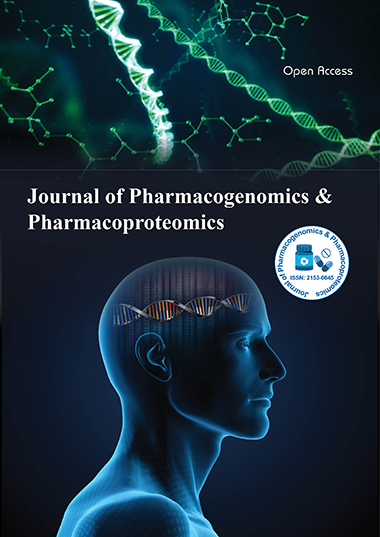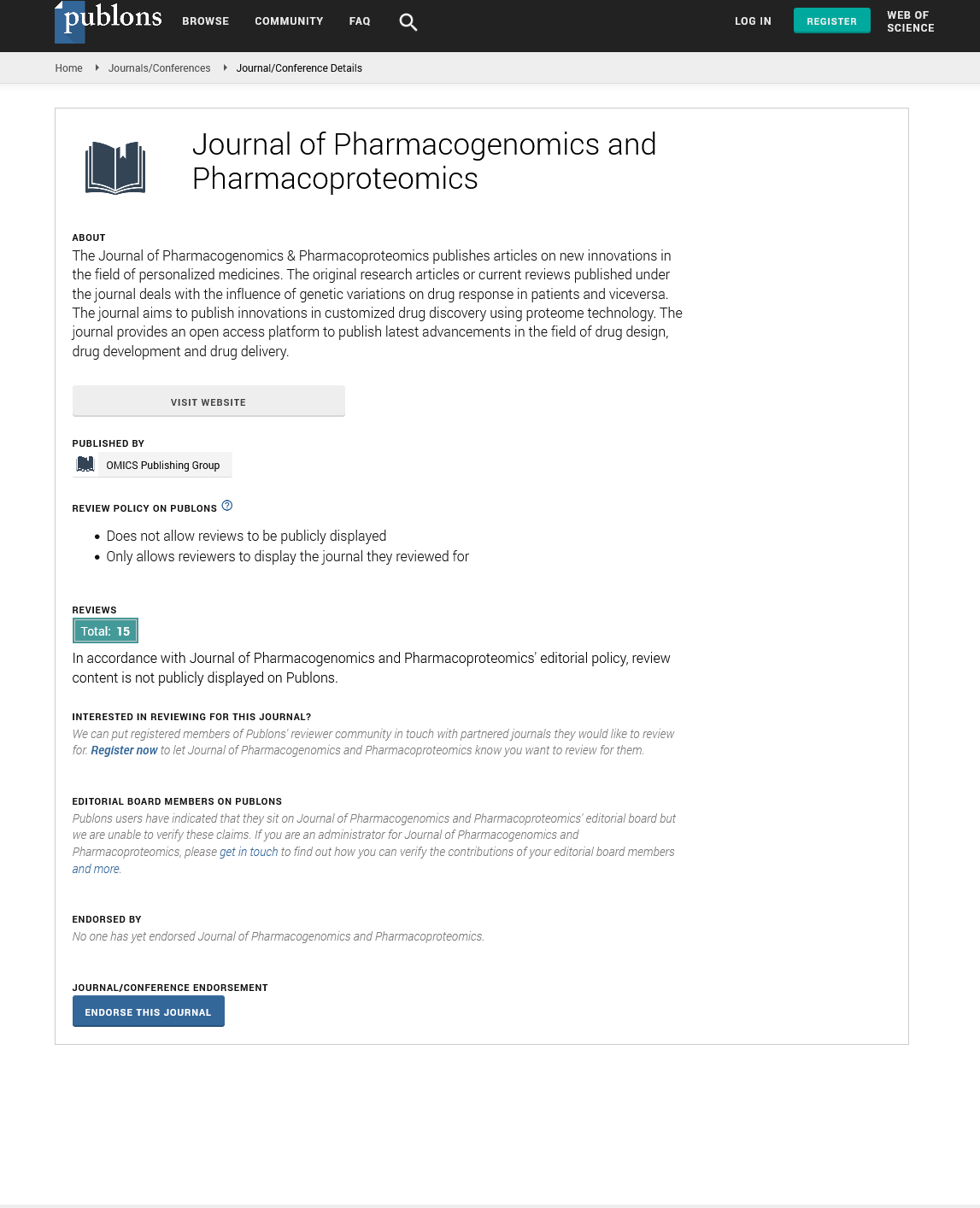Indexed In
- Open J Gate
- Genamics JournalSeek
- Academic Keys
- JournalTOCs
- ResearchBible
- Electronic Journals Library
- RefSeek
- Hamdard University
- EBSCO A-Z
- OCLC- WorldCat
- Proquest Summons
- SWB online catalog
- Virtual Library of Biology (vifabio)
- Publons
- MIAR
- Euro Pub
- Google Scholar
Useful Links
Share This Page
Journal Flyer

Open Access Journals
- Agri and Aquaculture
- Biochemistry
- Bioinformatics & Systems Biology
- Business & Management
- Chemistry
- Clinical Sciences
- Engineering
- Food & Nutrition
- General Science
- Genetics & Molecular Biology
- Immunology & Microbiology
- Medical Sciences
- Neuroscience & Psychology
- Nursing & Health Care
- Pharmaceutical Sciences
Short Communication - (2024) Volume 15, Issue 1
Dual Nature of Genetic Mutations: Balancing Risks Factors and Benefits of DNA Replication
Amonn Marissa*Received: 01-Jan-2024, Manuscript No. JPP-24-24894; Editor assigned: 05-Jan-2024, Pre QC No. JPP-24-24894 (PQ); Reviewed: 19-Jan-2024, QC No. JPP-24-24894; Revised: 26-Jan-2024, Manuscript No. JPP-24-24894 (R); Published: 02-Feb-2024, DOI: 10.35248/2153-0645.23.15.089
Description
Genetic mutations are changes or alterations in the DNA or RNA sequence of a gene or organism. These changes can be caused by external factors, such as radiation, exposure to chemicals, and viruses, or can occur due to mistakes during the replication of genetic materials. These alterations can lead to physical abnormalities and a variety of diseases including cancer. The complexity of genetic mutations is that these changes in the genetic code may lead to positive results, such as increasing the likelihood of surviving in environment, but can also cause negative outcomes like cancerous cells. The way that genes interact with one another is highly complex, so it is difficult to predict the way a mutation will affect an organism before it occurs. It is also difficult to predict how long-term mutations will affect generations down the line. For example, some genetic conditions are passed down from parent to child due to a single gene mutation that occurred many years ago. Additionally, the impact of external environmental factors on DNA is not always clear. The occurrence of genetic mutations is often random and unpredictable; however, some individuals may be more prone than others to suffer from certain types of mutations based on their family history and lifestyle choices. For instance, those who frequently come into contact with hazardous materials or chemicals have an increased risk for developing DNA-altering conditions due to their environmental exposures. Additionally, certain lifestyle choices such as smoking or drinking can increase an individual’s risk for developing illnesses caused by genetic mutations [1-3].
When exploring the complexities of genetic mutations it’s important to remember that there are both positive and negative effects associated with them. While some mutations may result in increased survival rates in harsh environments under certain conditions, others may lead to serious illness if neglected over time. It’s important for individuals with family histories of certain conditions related to gene mutations or those who have been exposed to hazardous materials or substances in their everyday lives understand these risks so they can make informed decisions about their health moving forward.
Genetic mutations are changes in hereditary information that occur when the DNA sequence in a gene or chromosome is altered. There are various causes of genetic mutations, including environmental factors and issues with DNA replication. Between these two causes, there is an array of complexities that must be explored to gain a better understanding of genetic mutations. DNA acts as the blueprint of our cells. It contains the instructions for all cellular activities within our bodies. When this blueprint is disrupted by a mutation, it can have severe impacts on our health. Environmental factors like smoking, high levels of radiation, and certain chemicals can cause genetic mutations due to their mutagenic properties. Radiation specifically targets DNA when it enters the cell and can cause several types of alterations in the sequence.
Another major cause of genetic mutations is errors during DNA replication. This process occurs when a cell has to divide into two daughter cells with identical copies of the original parent cell’s genetic material. During this process, mistakes can be made when copying genes from one strand to another which leads to changes in the order of nucleotides or base pairs that make up the double helix structure. The mistake that occurs during replication determines what kind of mutation will take place. Point mutations refer to single base pair changes within a gene such as substitutions or additions which result in altered gene products. Insertions are extra base pairs added into a gene while deletions result in lost nucleotides from a sequence [4-7].
Genetic mutations are complex changes in the genetic material of a cell that can cause alterations in the structure and function of a gene. These changes can affect DNA, the chemical instructions that direct how cells grow and divide, as well as RNA, which is synthesized from DNA and carries out the instructions encoded by genes. Genetic mutations can occur through changes in one single nucleotide or multiple nucleotides within a gene. Depending on the nature of these changes, there are four main types of genetic mutations: Point Mutations, Insertion Mutations, Deletion Mutations, and Chromosomal Mutations. Point mutations involve one single nucleotide that is changed due to substitutions or transitions. These mutations occur when a single nucleotide base is replaced with another in either DNA or RNA molecules. These replacements can be categorized as transition mutations when purines (A & G) are switched with other purines or pyrimidine’s (C & T) are switched with other pyrimidines. A substitution mutation occurs when a purine is replaced by a pyrimidine or vice-versa. While Point mutations may be beneficial depending on which amino acid is substituted during translation of mRNA to protein; most cases result in non-functional proteins. Insertion mutations involve adding one extra nucleotide into the existing sequence. This type of mutation leads to an increase in DNA length and causes a frame shift; meaning that all subsequent codons would be shifted into different reading frames as opposed to those before it resulting in incorrect translation into proteins. It’s important to note that while some amino acids may stay the same after an insertion mutation due to some codons having more than one possible anticodon; most insertions will cause non-functional proteins.
Deletions involve removal of one or more nucleotides from existing sequence resulting in loss of information being translated from DNA to protein synthesis. This type of mutation also leads to a decrease in DNA length and results in frameshifts similar to insertion mutations except this time leading to premature termination codons resulting in non-functional proteins. Chromosomal mutations involve more drastic changes due to structural rearrangements within chromosomes such as deletions, amplification/duplications and translocations involving long lengths of DNA sequences causing disruption into genes located [8-10].
References
- Zhou Y, Tremmel R, Schaeffeler E, Schwab M, Lauschke VM. Challenges and opportunities associated with rare-variant pharmacogenomics. Trends Pharmacol Sci. 2022; 43:852-865.
[Crossref] [Google Scholar] [PubMed]
- Kasuga T, Taylor JW, White TJ. Phylogenetic relationships of varieties and geographical groups of the human pathogenic fungus histoplasma capsulatum darling. J Clin Microbiol.1999;37:653-663.
[Crossref] [Google Scholar] [PubMed]
- Keeling NJ, Dunn TJ, Bentley JP, Ramachandran S, Hoffman JM, Rosenthal M. Approaches to assessing the provider experience with clinical pharmacogenomics information: a scoping review. Genet Med. 2021; 23:1589-1603.
[Crossref] [Google Scholar] [PubMed]
- Liu D, Olson KL, Manzi SF, Mandl KD. Patients dispensed medications with actionable pharmacogenomics biomarkers: rates and characteristics. Genet Med. 2021; 23:782-786.
[Crossref] [Google Scholar] [PubMed]
- Murata Y, Sano A, Ueda Y, Inomata T, Takayama A, Poonwan N, et al. Molecular epidemiology of canine histoplasmosis in Japan. Sabouraudia. 2007;45(3):233-247.
[Crossref] [Google Scholar] [PubMed]
- Habich C, Kempe K, Gomez FJ, Lillicrap M, Gaston H, van der Zee R, et al. Heat shock protein 60: identification of specific epitopes for binding to primary macrophages. FEBS letters. 2006;580(1):115-120.
[Crossref] [Google Scholar] [PubMed]
- Ajello L. Comparative morphology and immunology of members of the genus histoplasma: A review. Mycoses. 1968;11(7):507-514.
[Crossref] [Google Scholar] [PubMed]
- Chandler FW, Kaplan W, Ajello L. Histoplasmosis duboisii. A Colour Atlas and Textbook of the Histopathology of Mycotic Diseases. Wolfe Medical Publications.1980:67-69.
- Keeling NJ, Dunn TJ, Bentley JP, Ramachandran S, Hoffman JM, Rosenthal M. Approaches to assessing the provider experience with clinical pharmacogenomics information: a scoping review. Genet Med. 2021; 23:1589-1603.
[Crossref] [Google Scholar] [PubMed]
- Liu D, Olson KL, Manzi SF, Mandl KD. Patients dispensed medications with actionable pharmacogenomics biomarkers: rates and characteristics. Genet Med. 2021; 23:782-786.
[Crossref] [Google Scholar] [PubMed]
Citation: Marissa A (2024) Dual Nature of Genetic Mutations: Balancing Risks Factors and Benefits of DNA Replication. J Pharmacogenom Pharmacoproteomics. 15:089.
Copyright: © 2024 Marissa A. This is an open-access article distributed under the terms of the Creative Commons Attribution License, which permits unrestricted use, distribution, and reproduction in any medium, provided the original author and source are credited.

